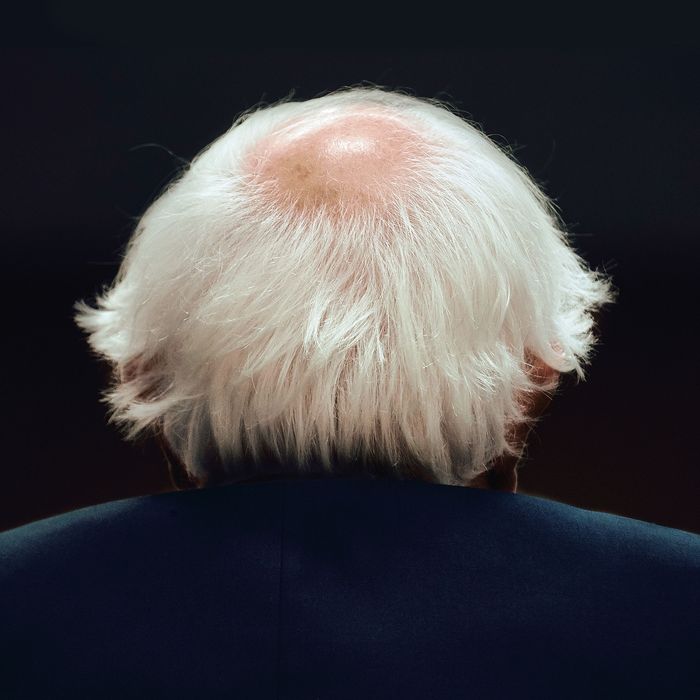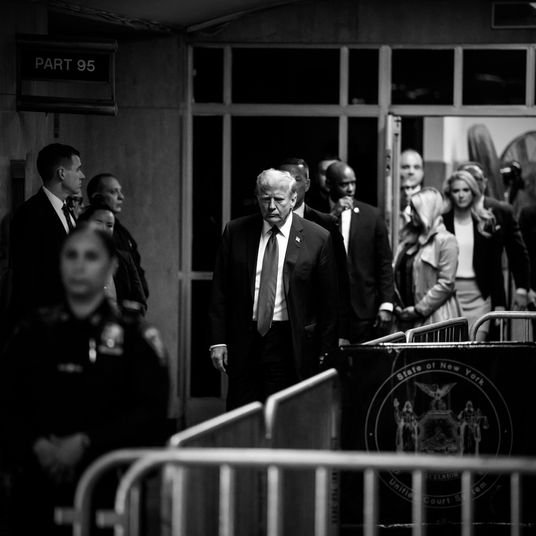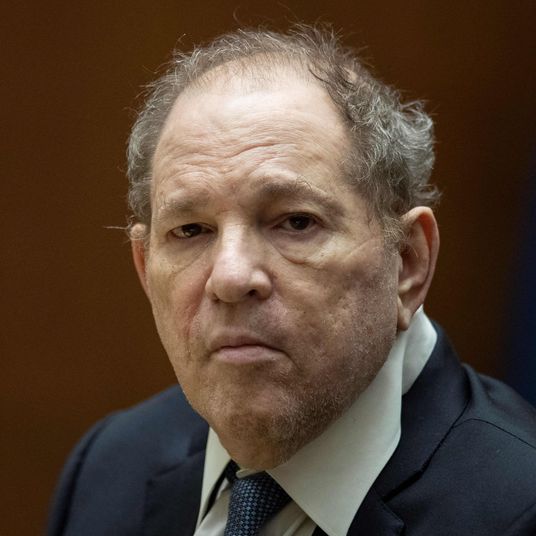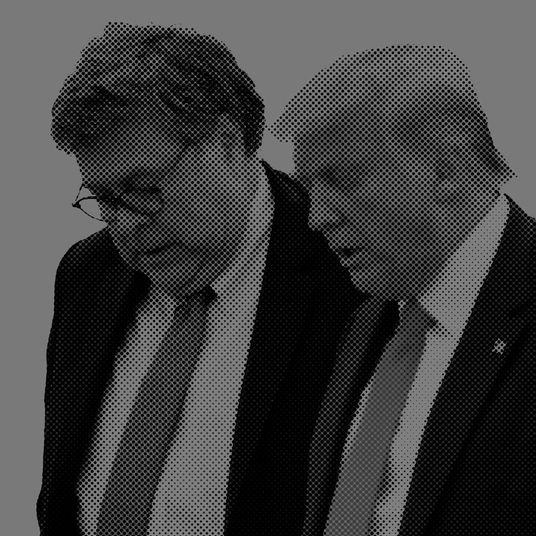
Bernie Sanders was gratified, if a bit amused, to hear Barack Obama call Medicare for All a “good new idea” in September. The idea has recently become very popular among Democratic politicians, even middle-of-the-road ones with presidential aspirations. In recent polling, 70 percent of Americans say they support it. But of course Medicare for All isn’t a new idea. It was one of the pillars of Sanders’s 2016 campaign for president. He’s been talking about a version of it for over 30 years.
For a 77-year-old man fixated on the popularity of his ideas and his candidacy — “Harry, have you seen my crowds?” he once asked then-Senator Harry Reid by way of a greeting in the heat of the 2016 campaign — Sanders sometimes finds opportunities like these to enjoy his newfound influence in the Democratic Party. But mostly, he is ill at ease. He talks in private much as he does in front of a microphone, except with a lot more sarcasm. He continues to get angry at Establishment liberals, whose dismissals of how he sees the world he takes personally and judges personally. (He believes their positions and motivations can rarely be disentangled from their funding.) His frustration with the press has only grown. “You mean inside-the-Beltway writers may have missed the point here?” he says to me recently, eyebrows up, when we sit down to talk.
And he still thinks he should be president. He doesn’t say this out loud, exactly. “I’m not one of those sons of multimillionaires whose parents told them they were going to become president of the United States,” he says. “I don’t wake up in the morning with any burning desire that I have to be president.” Still, he’s pretty certain he’s already the country’s second-most-important politician, and the logic for running in 2020 is obvious to him: His ideas are the best for the country, a majority of Americans will agree once they’re exposed to them, no other national politician has proved to be as uncompromised or effective a messenger of his platform as he is, and no one else seems better positioned to actually win. “If there’s somebody else who appears who can, for whatever reason, do a better job than me, I’ll work my ass off to elect him or her,” he says. But “if it turns out that I am the best candidate to beat Donald Trump, then I will probably run.” He’s been mulling the question all year as he bounds across the country. A longtime friend of Sanders’s characterizes his position as, “At this point, what does he have to lose?”
One plausible answer to that question: quite a lot. “In many ways, the world has caught up with him,” says Nina Turner, a former Ohio state senator running Our Revolution, the political organization spawned from his campaign. But even some of the people close to Sanders — all of whom agree with that assessment — are not necessarily certain another presidential campaign is the best vehicle for his cause. “Bernie is not accountable to anything,” says one longtime ally. “He thinks it’s all about him” and not always a broader movement.
Even the decision not to decide yet has caused anguish, both for Sanders personally and for anyone who might run against him in the primaries. He is now the dean of the American left — the incumbent leader, as it were, of the most energized segment of the national electorate — and everyone is watching to see how he spends the substantial political capital he has, over a four-decade career, recently accumulated.
One week before Trump’s inauguration, Sanders was steaming. He’d returned to Washington to fight, but he found his colleagues unable to internalize what went wrong. When 13 Senate Democrats nixed a measure to decrease drug prices through Canadian imports, he vented to USA Today that they didn’t have “the guts” to do the right thing, promising they’d hear from him. Behind the closed doors of the Democratic caucus, the backlash from his colleagues was swift. Four of the senators who’d crossed Sanders were centrists up for reelection in states Trump had just won. They already faced pressure from their right; none could afford for Sanders to train his large and energized audience against them. For the first time, he scared them — and this was new to him, too. The prospect of exerting this kind of power opened up new possibilities of influence but also potential pitfalls. Sanders backed down and retreated to his third-floor Senate office to iron out with advisers what, exactly, his new role should look like.
His first step was agreeing to be more of a team player in the Senate, which meant building relationships with powerful party members. He had already accepted Minority Leader Chuck Schumer’s invitation to join the Senate leadership team. He also hired Ari Rabin-Havt, a former senior aide to Reid, and they quickly found an opportunity to persuade his colleagues to hear him out: working to protect Obama’s signature legislative accomplishment, the Affordable Care Act. Sanders had never made any secret of his dissatisfaction with the law or his preference for a single-payer health-care system. But he saw health care as the defining fight of Trump’s term and pitched Schumer on helping organize rallies that winter. He spent much of the first half of 2017 traveling to states represented by key Republican senators to rile up voters around saving the ACA.
This, in turn, earned him enough goodwill among skeptical party figures to at least open relations. “For a long time, Bernie believed in organizing but ran solo,” says Randi Weingarten, the head of the American Federation of Teachers, who tells me she has worked with Sanders more in the past two years than at any time in memory. With Schumer’s support, Sanders joined Democratic National Committee chairman Tom Perez for a “unity” tour, which, while rocky in its public reception, forced the pair to properly meet and interact for the first time. “The wound that was left in the Democratic Party in 2016 is healing in the context of opposition to Trump,” says Jeff Merkley, the lone senator to endorse Sanders in the 2016 primaries. “You finally have the Democratic Party coming back to its Roosevelt roots.”
Meanwhile, Sanders experimented with ways to use his popularity as a cudgel against the president. When he’d first sat down to recalculate his life after the 2016 campaign, a top priority was an overhaul of his digital-media operation. He hired Armand Aviram, a former producer from NowThis News, and cameras now follow him everywhere; in 2017, the team published 550 short videos for Facebook and Twitter. They are enormously popular — town halls streamed on Facebook can earn millions of views — and Sanders constantly asks aides for updates on his viewership and sharing numbers. The project is substantially more ambitious than that of any other politician in Washington. (In April, aides from multiple Senate offices told me they had no idea how Sanders was doing it.) In fact, the only person in Washington who seems to care as much about building his own media ecosystem is Trump.
It’s this audience, and the pressure it can exert, that Sanders often credits with pulling his party toward him on specific issues. “Not only Hillary Clinton, not only the Establishment media, not only every op-ed writer in America — they said, ‘Bernie Sanders is crazy, these ideas are extreme, they’re fringe, nobody believes in it, this is not what America is supposed to be about,’ ” he tells me, pounding his index finger on the table as he talks about the presidential-announcement speech he gave in May 2015. Now, “virtually every one of the issues that I talked about” — he lists basically his full campaign platform — “today are mainstream, and today are supported by, in many cases, a vast majority of the American people.” He advocated curtailing the influence of superdelegates in the party’s presidential-nominating process, a change that was codified in August. And he succeeded in bending the national conversation around health care not just away from repealing Obamacare but in the direction of Medicare for All. After the first serious Republican attempt to repeal the ACA was defeated in July 2017, he started wooing colleagues to his own measure, which for years had been widely regarded within the party as unrealistically ambitious, not to mention a rebuke of Obama. He also played his outside game: One video of a Canadian doctor explaining her country’s health-care system earned more than 30 million views on Sanders’s Facebook page. When Sanders introduced his measure in the Senate that September, 16 Democrats co-sponsored it, including Cory Booker, Kirsten Gillibrand, Kamala Harris, and Elizabeth Warren.
None of which is to say that Sanders, still an Independent, and the Democratic Establishment have altered their opinions of each other much. His advisers believe the party still doesn’t appreciate how respectfully he treated Clinton — he never brought up her emails! — or how useful he was in energizing young voters after the primaries. Clinton loyalists find this analysis laughable to the point of offensiveness. In Washington, there’s still no shortage of Sanders critics within the party, people who see him as a cranky narcissist with a victim complex, or an old, out-of-touch white man with few legislative accomplishments, or someone deluded into thinking his success has to do with anything other than being the alternative to Clinton. Even some activists sympathetic to Sanders see him exercising his political muscle on the health-care and tax debates and wish he’d play a bigger role in the party’s thorniest fights — over Trump’s Muslim ban or the Dream Act, for example. “He’s never been totally comfortable being full-throated in his opposition to Trump, although he does all of it,” one of his Senate colleagues tells me. “He’s more comfortable making Democrats uncomfortable.” This line of argument drives Sanders crazy.
Early this summer, Sanders celebrated the publication of his former campaign manager Jeff Weaver’s memoir of the 2016 race. The book was already controversial in Washington: It’s called How Bernie Won. In his brief remarks at the party, Sanders agreed. “In many ways, we did win the election,” he said. Hours earlier, Justice Anthony Kennedy had announced his retirement. To pretty much every Democrat not at that book party (and to many who were there), the day was a particularly demoralizing reminder of how much they had lost.
I ask Sanders what would be different about his presidential campaign this time around, if he runs, and he laughs. “It’s almost personally embarrassing to tell you how little we knew,” he says. Later he describes running for president as “five Ph.D.’s wrapped up in six months.”
In January, Sanders convened his inner circle at Rabin-Havt’s to talk through his future. Weaver and Turner were there, as were half a dozen other advisers. Sanders’s wife, Jane, dialed in. The attendees took turns presenting, explaining that if Sanders chose to run for president again, the dynamics would be significantly different — the “Bernie is just too eccentric, too untested” argument would be out the window with Trump in office, and Sanders would likely enter the primary this time as a front-runner, not an amusement. They framed the choice: If you want to focus on your legacy and influencing the party, we understand. But if you want to do this, they told him, say “Go.” The campaign couldn’t afford to be like the last one, which got off the ground only after Sanders’s then–chief strategist, Tad Devine, tired of the senator’s foot-dragging, leaked that an announcement was coming in order to force his hand. Sanders listened, told his advisers he hadn’t yet decided, and instructed them to do whatever was necessary to get him ready for “Go” in case he got there.
And so the team mapped out a 2018 political plan that could best position him for a 2020 run. Sanders has now visited 34 states since the 2016 election, including 22 that voted for Trump. Over the 20 days before the midterms, he sprinted through 13 of them, traveling more on behalf of midterm candidates than any other likely presidential contender except Joe Biden.
It’s not hard to see how someone in Sanders’s shoes could be a little discouraged by November’s results: The high-profile candidates he backed most vociferously, like Ben Jealous of Maryland and Randy Bryce of Wisconsin, lost. So did many of the candidates he’d backed in primaries, like Virginia’s Tom Perriello and Michigan’s Abdul El-Sayed. (He didn’t endorse Alexandria Ocasio-Cortez, the single biggest electoral success story for the Sanders wing of the party, in her primary campaign.) Our Revolution, which aimed to support progressive candidates in 2018, had a mediocre showing; though it had some down-ballot successes, it failed to flip a single House seat. There is no doubt that Sanders and his organization helped energize progressive campaigns and popularize his positions among new and incumbent candidates. But paradoxically, the results of the midterms — the largest leftward shift in the American electorate since the aftermath of Richard Nixon’s resignation — might have made a Sanders presidential campaign look more difficult.
Sanders’s advisers admit that his path to the Democratic nomination mirrors Trump’s in 2016. Facing what’s likely to be a historically large field, he’s been told, Sanders could start with his most loyal supporters from last time and go for a tight plurality victory in Iowa’s caucuses, followed by a slightly bigger one in New Hampshire’s primary. From there, advisers hope, his numbers could grow as the field dwindles. “There’s a 25 percent base of the party that isn’t going anywhere, and I think 25 percent, in a ten-person primary, is very formidable,” says a former adviser. But everyone recognizes that the strategy is tough — “It is the only thing you can tell yourself and draw a plausible route to the nomination,” says David Axelrod, Obama’s political architect — and everything will depend on who emerges as considerable rivals and how they chip away at his base of support. In January, Sanders’s team reviewed the potential field with him, lingering on the possibility of Warren and Biden entering the race. (An October CNN survey showed Biden 20 points ahead of Sanders across the country, though other polls show a smaller margin.) Sanders made clear that he was also wary of Booker, whom he regards as a potent messenger. In the months since, his aides have kept close tabs on the maneuvers of a wide range of potential candidates, questioning whether Warren intends to run as, in the words of multiple Sanders allies, “Bernie-light” and smiling at the prospect of a matchup against Michael Bloomberg.
Everyone in Sanders’s orbit recognizes the difficulty he’s had in speaking beyond issues of economics and political corruption. “The 2020 challenge will be making sure [he] can inclusively get the class message out in a way that doesn’t make it seem like he’s dismissing identity issues,” says one Sanders adviser. To this end, he has established public relationships with the reverends Dr. William Barber and Al Sharpton, as well as Randall Woodfin and Chokwe Antar Lumumba, the young African-American mayors of Birmingham, Alabama, and Jackson, Mississippi, respectively. But he continues to say things that exacerbate his problems. In April, he faced backlash for appearing to dismiss Obama as just a “charismatic individual,” and, more recently, some black lawmakers bristled at what they perceived as Sanders’s attempt to take credit for Andrew Gillum’s primary win in the Florida governor’s race. Then, as the results were tallied in Florida and Georgia, Sanders had trouble calling voters who were uncomfortable with voting for black candidates “racist,” though he did use the word to describe some GOP candidates’ campaigns. At a May conference hosted by the liberal Center for American Progress think tank, Sanders’s speaking slot was billed as “Focus on Criminal Justice.” But when his office sent out his prepared remarks, it looked like a modified version of his old stump speech.
The title was “Breaking Up the Oligarchy.”
Mostly, Sanders’s advisers fear that he doesn’t fully appreciate how difficult another run will be. The primaries alone will cost hundreds of millions of dollars, they’ve told him. Staffing up will be complicated. In recent months, his allies have talked about 2020 roles with dozens of former and potential campaign workers, many of whom are concerned that the main change he talks about making this time around is assembling a more robust digital team. (As long as Sanders’s inner circle includes Weaver, many senior 2016 staffers will take themselves out of the running or Weaver will remove them. He is polarizing even by the standards of political-campaign operatives.) And the race will almost certainly be more negative this time around. In July, over 200 centrist Democratic lawmakers, operatives, and donors met in Columbus, Ohio, to plan how to beat both Trump and Sanders.
But Sanders can’t believe a 2020 race will be any more cynical or negative than the last one. In his experience, the attacks against him and his wife were so raw that he hasn’t asked his advisers for the customary “self-research” that might surface new vulnerabilities. “Look, you don’t even need [opposition research],” he tells me. “If I were a choirboy, it doesn’t matter, because they lie all the time.” But Clinton’s team never ran television ads against Sanders that attacked him personally, and even people close to him fear the amount of potential material is considerable. No opponent has done a full dive through Sanders’s years’ worth of television clips and essays — in 2015, an article he wrote in 1972 that included a line about a woman who “fantasizes being raped by 3 men simultaneously” resurfaced and became a brief political flash point — or succeeded in persuading him to release a full accounting of his taxes. There are also his appearances on RT, the Russian-government-funded network, during the 2016 campaign, and his team’s hesitancy to reckon with Robert Mueller’s finding that Russian agents at one point supported his campaign.
When I ask Sanders if there’s anything he wishes he’d done differently over the past two years, he quickly says, “I’m sure there are a million things.” But then, just as quickly, he backtracks. “You always … I don’t … Nothing, you know, jumps out at me.”
On October 2, Sanders’s day began with an email from an aide informing him that if he checked the news, he’d see Amazon had just raised its minimum wage to $15 an hour for U.S. employees. This is the kind of victory he still isn’t used to celebrating, and later that morning he wondered aloud whether it was his most important accomplishment ever.
Activists had been fighting for a higher minimum wage at Amazon for years, and Sanders had recently used his fame to call attention to it. On an issue like this, he’d told his team, it helps to stop thinking like a senator and start thinking primarily like someone with a huge platform. In July, he’d live-streamed a town hall with workers from Disney, Amazon, American Airlines, Walmart, and McDonald’s; by August, Disney World announced it planned to raise its minimum wage to $15. In September, he introduced legislation in the Senate, following a similar bill introduced by California representative Ro Khanna last year, intended to pressure Amazon, knowing that by signing on to it, he would give the legislation a new round of attention. They branded this version the Stop Bad Employers by Zeroing Out Subsidies Act — “Stop BEZOS.”
When liberals worried the proposal would backfire, Sanders’s team argued they’d missed the point: The bill wasn’t intended to become law. “You use the opportunity you have within the context that you’re forced to work,” Sanders says. “Right now, nothing good is going to happen for workers in this Congress, and therefore we have to go outside.” This month, he introduced the Stop Walmart Act, and he’s pushing the new Democratic House majority to pass a national $15 minimum wage.
And yet, as proud as he is to have found ways to put a dent in income inequality — under a Trump administration, no less — Sanders finds a lot of his newfound fame deeply unpleasant. He has talked with friends about the pressure of being, in his mind, the most popular politician in the country. He travels constantly but can’t go anywhere without being mobbed. He shoos away cameras that get too close, cuts off questioners. “It’s hard to walk down the street without people coming up to you,” he says. “There’s no interview I can give that does not have the possibility of a ‘gotcha’ question. ‘Oh, we can trap him, embarrass Sanders.’ ” His decision to at least partially ingratiate himself with the Democratic Establishment is its own kind of heartache. He believes he has a responsibility to shape the party in his image, but at what point do these negotiations turn him into just another politician?
Whenever Sanders is asked about his age, he reddens, cracks an annoyed smile, tilts his head down to peer above his glasses, and opens his eyes wide. The question, he tells me, holding eye contact far more than usual, is getting annoying. “If we say, ‘Oh my God, I have a communications director here who’s a woman,’ oh my God, you would go crazy. I would be pilloried all over the country: I’m a sexist guy. ‘Oh my God, we’re working with African-Americans!’ I don’t know: lalalala,” he says. “And yet — yet! — I think ageism is a real issue, okay? And I think when we look at individuals, we look at their totality, all right? There are, you know, 50-year-olds who retired for whatever reason, people who are dealing with terrible illnesses, all right? Age is a factor! But it is one of many factors!
“I thank God, you know, I can’t remember the last day — honestly — when I missed work,” he continues. Opponents make his age an issue only when they can’t compete on issues, he says. “What people have a right to know: Is the candidate healthy? Does he or she have the energy to do what is a very stressful and difficult job?”
Some close Sanders allies do think his path to the White House has never been clearer. But other friends have warned him there’s a good chance that if he enters the race, his first day will be his best day. They’ve softly nudged him to consider the symbolic power of handing off his mantle to a younger leader — as well as the influence he’d wield over the primary races if he strategically withheld his support. “His message is one that obviously resonated a couple years ago,” says Tom Harkin, the former Iowa senator whom Sanders consulted before his last campaign. Now, Harkin says, other Democrats must acknowledge that “Bernie’s message is heightened by what Trump has done.”
A lot likely comes down to Warren, whom Sanders has called “my favorite senator.” In 2016, according to advisers, the prospect of a Warren campaign nearly kept Sanders out of the race. Now some Sanders allies watching her maneuver toward 2020 perceive her trying to elbow him out. Neither senator has expressed any interest in stepping aside for the other, and the pair have mostly ignored entreaties from allies to meet in person and hash out an agreement. But given the complexity of launching a campaign, Sanders will have to make the decision in the next few months or the calendar will make it for him.
“The question that history will answer, depending on what he decides to do, is: Is he going to be the Barry Goldwater or the Ronald Reagan?” says Khanna. “Is he going to be the person who defines the ideology to have someone else win?” Sanders is pretty certain that even being president wouldn’t satisfy him — activism is a constant struggle, he tells people, and it’s a classic politician’s mistake to believe in such a thing as an endgame. But for the first time in his career, he’s seeing the country shift in his direction. The revolution is “already off the ground,” Sanders tells me, as if it were the most obvious thing in the world. “The genie is out of the bottle.”
*This article appears in the November 26, 2018, issue of New York Magazine. Subscribe Now!
































